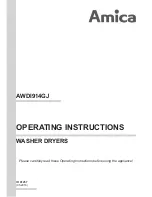
P
I
02 9604 1226 E
I
|
danielaappliances.com.au
PA G E 2 5
P
I
02 9604 1226 E
I
|
danielaappliances.com.au
PA G E 2 4
HOW TO CONNECT THE SAFETY SUPPLY HOSE
The following things should be checked before starting the dishwasher:-
1.
The dishwasher is level and fixed properly
2.
The inlet valve is open
3.
Fill hose connections are fully tightened and not leaking
4 . The wires are tightly connected
5.
The power is switched on
6.
The inlet and drain hoses are knotted
7.
All packing materials and printings should be taken out from the dishwasher.
TROUBLESHOOTING TIPS
BEFORE CALLING FOR SERVICE
Reviewing the charts on the following pages may save you from calling for service.
PROBLEM
POSSIBLE CAUSES
WHAT TO DO
Dishwasher
doesn’t start.
Fuse blown, or the circuit
break tripped.
Power supply is not
turned on.
Water pressure is low.
Door of dishwasher not
properly closed.
Replace fuse or reset circuit breaker.
Remove any other appliances sharing the same
circuit with the dishwasher.
Make sure the dishwasher is turned on and the
door is closed securely. Make sure the power cord
is properly plugged into the wall socket.
Check that the water supply is connected properly
and the water is turned on.
Make sure to close the door properly and latch it.
Water not
pumped form
dishwasher.
Twisted or trapped
drain hose.
Filter clogged.
Kitchen sink clogged.
Check the drain hose.
Check coarse the filter.
Check the kitchen sink to make sure it is draining well.
If the problem is the kitchen sink that is not draining,
you may need a plumber rather than a serviceman
for dishwashers.
PROBLEM
POSSIBLE CAUSES
WHAT TO DO
Suds in the tub.
Wrong detergent.
Spilled rinse-aid.
Use only the special dishwasher detergent to avoid
suds. If this occurs, open the dishwasher and let suds
evaporate. Add 1 gallon of cold water to the bottom
of the dishwasher.
Close the dishwasher door, then select any cycle.
Initially, the dishwasher will drain out the water.
Open the door after draining stage is complete
and check if the suds have disappeared.
Repeat if necessary.
Always wipe up rinse-aid spills immediately.
Stained tub
interior.
Detergent with colourant
was used.
Make sure that the detergent is the one
without colourant.
White film on
inside surface.
Hard water minerals.
To clean the interior, use a damp sponge with
dishwasher detergent and wear rubber gloves. Never
use any other cleaner than dishwasher detergent for
the risk of foaming or suds.
There are rust
stains on cutlery
The affected items are not
corrosion resistant.
A programme was not run
after dishwasher salt was
added. Traces of salt have
gotten into the wash cycle
The lid of the softer is loose.
Always run the quick wash programme . without any
crockery in the dishwasher and without selecting the
Turbo function (if present), after adding dishwasher salt.
Check the lid. Ensure the fix is fine.
Knocking noise in
the wash cabinet
A spray arm is knocking
against an item in a basket.
Interrupt the programme, and rearrange the items
which are obstructing the spray arm.
Rattling noise in
the wash cabinet
Items of crockery are loose
in the wash cabinet.
Interrupt the programme, and rearrange the
items of crockery.
Knocking noise in
the water pipes
This may be caused by on-
site installation or the cross-
section of the piping.
This has no influence on the dishwasher function.
If in doubt, contact a suitably qualified plumber.



































